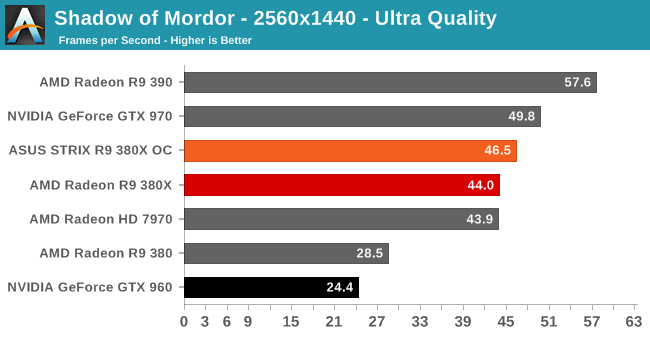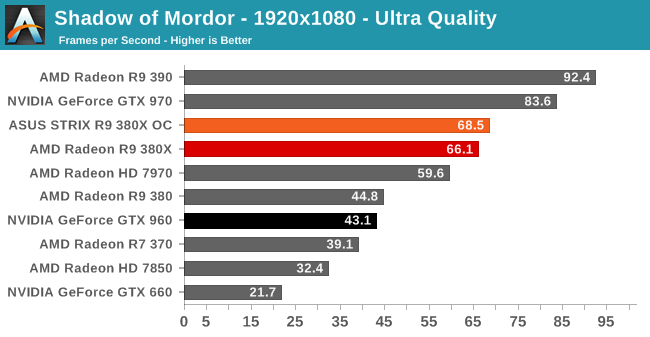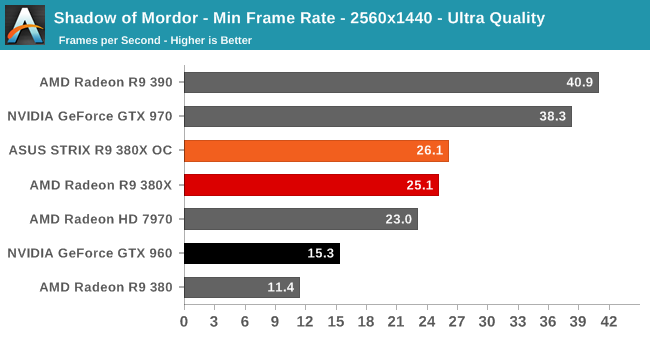The AMD Radeon R9 380X Review, Feat. ASUS STRIX
by Ryan Smith on November 23, 2015 8:30 AM EST- Posted in
- GPUs
- AMD
- Radeon
- Asus
- Radeon 300
Middle Earth: Shadow of Mordor
Our next benchmark is Monolith’s popular open-world action game, Middle Earth: Shadow of Mordor. One of our current-gen console multiplatform titles, Shadow of Mordor is plenty punishing on its own, and at Ultra settings it absolutely devours VRAM, showcasing the knock-on effect that current-gen consoles have on VRAM requirements.


Shadow of Mordor is the first game in our benchmark suite that really hammers memory capacity, which in turn drives a very large wedge between the 4GB R9 380X and the 2GB R9 380 and GTX 960. There’s simply no comparison here; even at 1080p the R9 380X is 50% or more ahead. And situations like this are a big reason that I believe that anything other than a budget card should come with 4GB at this time. Even if one is not buying an R9 380X, they should at least be buying a 4GB R9 380 or GTX 960.
Meanwhile it’s interesting to note that this is the only game that shows a real advantage for the R9 380X over the 7970. It’s possible that we’re looking at the differences in 3GB of memory versus 4GB, but given the results at 1440p versus 1080p, I suspect there’s a bit more going on here. Either way it shows that there will be times where a full Tonga card is a distinct improvement over a full Tahiti card.


Our minimum framerates reiterate what we saw in our averages. Even at 1080p the smaller 2GB cards get hit hard.










101 Comments
View All Comments
SpartyOn - Monday, November 23, 2015 - link
My 770 is at 1400 MHz core / 7940 MHz memory; trust me, neither the GTX 960 or this 380x are beating me and I'm not digging into my wallet until Pascal comes out. It was tough when the GTX 980 Ti was released, but I'm sticking to my guns.At 1080p, which is where the 960 and 380x should be competing (because if you buy either of these for 1440p+, you're a moron), if they had gotten a 960 4GB for comparison, there wouldn't be much difference. You can get a 960 4GB, which is a one year old card, for less than $200 and it's essentially just as good at stock. The few frames the 380x wins in this review is mostly due to the VRAM limit on the 960 2GB.
Plus you can overclock a 960 to insane levels, so why spend $229 on the 380x when you can spend $180 on a GTX 960 4GB and overclock it if you want more speed?
Sushisamurai - Monday, November 23, 2015 - link
Errr... Isn't the 960 a rebadge of the 770?Sushisamurai - Monday, November 23, 2015 - link
Note: rebadge in the sense that the hardware is super similar, minus the maxwell gen 2 featuresSushisamurai - Monday, November 23, 2015 - link
Oops I lied. The 770 is not comparable to the 960; I'm assuming it's better. Mind u, the 280X and 770 were comparable back in the day.silverblue - Monday, November 23, 2015 - link
Yep, as the 770 is essentially a tweaked 680, which traded blows with the 7970/7970GE,CiccioB - Tuesday, November 24, 2015 - link
The sad thing is how all you make comparisons on this kind of technology. GPU scales well when made fat. So the point of "performance" is really moot when doing comparisons. It's like saying that the 750Ti is the same as a GTX480 because they perform similarly.This card (like all the new AMD 300 series) are simply fat, bloated, clocked at their limit GPUs that are sold under cost to compete with smaller more efficient architectures created by the competition (that is selling them at premium prices).
This 380X card is a complete fail in trying to make AMD advance in its fight. Competition has done marvelous things meanwhile: they came with a GPU, the GM106, which is half the GK104 in term of size and power consumption, and has the same performances. This is the progress the competition did while AMD passed from GCN 1.0 to GCN 1.2, which has only few tricks and hacks but nothing really good to bring that already obsolete architecture to the new level of competition.
Sorry, but if you are excited by this kind of "evolution" and you do not understand where this has brought "your favorite company" to, you really deserve to stay a generation back in terms of innovations. And be happy of this Tonga which will be sold for few bucks in few month and be completely forgotten when Pascal will annihilate it at it first iteration.
britjh22 - Monday, November 23, 2015 - link
Comparing a 2.5 year old card that cost $450-500 against a $230 card.... and complaining if AMD is even trying... your bias is showing sir. You shouldn't feel the need to upgrade yet in my opinion, unless of course your card is being crippled by NVIDIA's drivers, whoops!tviceman - Monday, November 23, 2015 - link
GTX 770 launched at $399, not $450. Interestingly, the GTX 770 was a smaller chip and drew less power. So, tossing the consumer economics aside, SpartyOn raises a good point.britjh22 - Monday, November 23, 2015 - link
The 770 2GB launched at $399, but the 4gb launched at anywhere from $450 to $500 depending on the model.200380051 - Monday, November 23, 2015 - link
The power consumtion of the 380X under load is lower with Furmark than it is with Crysis 3, while it is the opposite with the GTX 960. Any thoughts on that?